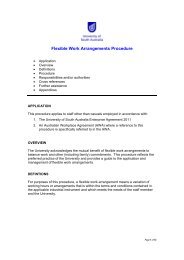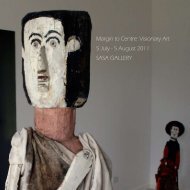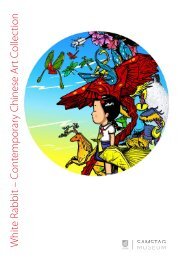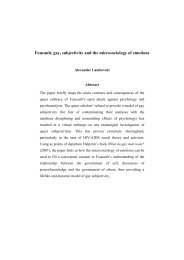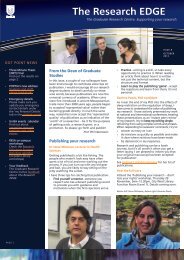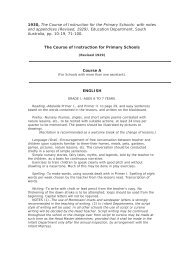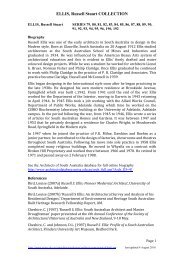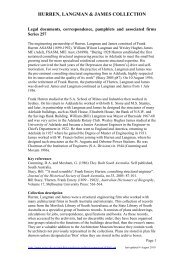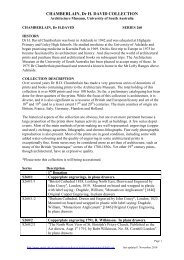'The Asian Delegation Chooses […] the Wu-Tang Clan!'—
'The Asian Delegation Chooses […] the Wu-Tang Clan!'—
'The Asian Delegation Chooses […] the Wu-Tang Clan!'—
Create successful ePaper yourself
Turn your PDF publications into a flip-book with our unique Google optimized e-Paper software.
1<br />
‘The <strong>Asian</strong> <strong>Delegation</strong> <strong>Chooses</strong> [<strong>…</strong>] <strong>the</strong> <strong>Wu</strong>-<strong>Tang</strong> <strong>Clan</strong>!’—<br />
Sustaining hip-hop culture through strategic appropriation of<br />
<strong>Asian</strong>/American culture<br />
Graham Chia-Hui Preston<br />
University of Melbourne<br />
On <strong>the</strong> second season premiere of <strong>the</strong> immensely popular and critically important<br />
Chappelle’s Show sketch comedy television program, Dave Chappelle stages his version of<br />
what he calls <strong>the</strong> ‘Racial Draft 2004.’ Modeled upon <strong>the</strong> amateur drafts of sports like<br />
football, basketball, baseball and hockey, <strong>the</strong> Racial Draft consists of racial groups (Whites,<br />
Blacks, Latinos, Jews, <strong>Asian</strong>s) selecting and naming an interracial individual as a member of<br />
<strong>the</strong>ir ‘race.’ As Chappelle notes in <strong>the</strong> ‘wraparound’ segment that introduces <strong>the</strong> sketch, ‘we<br />
all mixed up. I mean genetically *<strong>…</strong>+ We need to just settle this once and for all. We need to<br />
have a draft. That’s right I said it’ (Chappelle’s Show 2004). Chappelle offers examples like<br />
Halle Berry, Derek Jeter and Tiger Woods as famous figures whose ‘mixed’ racial and genetic<br />
makeup incites arguments and confusion between <strong>the</strong> ‘races’, including within Chapplle’s<br />
own family. He tells us that he and his Chinese wife argue over which ‘side’ of Tiger Woods<br />
is ‘hitting <strong>the</strong> ball so well’ (Chappelle’s Show 2004). The Racial Draft though, as Chappelle’s<br />
African American commentator character comments, ‘will state <strong>the</strong> racial standing of <strong>the</strong>se<br />
Americans, once and for all’ (Chappelle’s Show 2004).<br />
During <strong>the</strong> course of this eight minute sketch, <strong>the</strong>re are seven selections but, for <strong>the</strong><br />
purposes of this paper, I would like to only discuss <strong>the</strong> last choice. The <strong>Asian</strong> or Chinese<br />
delegation (<strong>the</strong> two terms are used interchangeably) holds <strong>the</strong> final selection and a white<br />
commentator notes that <strong>the</strong>y have ‘been waiting with Zen-like patience’ (Chappelle’s Show<br />
2004). In <strong>the</strong> climax of <strong>the</strong> sketch, <strong>the</strong> head <strong>Asian</strong> delegate, dressed in clo<strong>the</strong>s that are<br />
Online Proceedings of ‘Sustaining Culture’ (2008)<br />
Annual Conference of <strong>the</strong> Cultural Studies Association of Australia (CSAA)<br />
UniSA, Adelaide December 6-8, 2007<br />
http://unisa.edu.au/com/csaa/onlineproceedings.htm
vaguely reminiscent or stereotypical of Communist Chinese fashions of <strong>the</strong> 1960s,<br />
cautiously approaches <strong>the</strong> microphone and exclaims, ‘<strong>the</strong> <strong>Asian</strong> delegation chooses <strong>the</strong> RZA,<br />
<strong>the</strong> GZA, U-God, Inspectah Deck, <strong>the</strong> Ghostface Killah: <strong>the</strong> <strong>Wu</strong>-<strong>Tang</strong> <strong>Clan</strong>!’ (Chappelle’s Show<br />
2004). The commentators declare that <strong>the</strong> <strong>Asian</strong> delegation has made <strong>the</strong> shock pick of <strong>the</strong><br />
night by choosing <strong>the</strong> exclusively African-American hip-hop group. The <strong>Wu</strong>-<strong>Tang</strong> <strong>Clan</strong>,<br />
however, are well known for <strong>the</strong>ir appropriation and sampling of <strong>Asian</strong> (American) cinema<br />
and culture in <strong>the</strong>ir work and identity. The RZA and <strong>the</strong> GZA—<strong>the</strong> two de facto leaders of<br />
<strong>the</strong> hip-hop group—come up on stage to joyously accept <strong>the</strong> selection. The RZA exclaims,<br />
‘this is big for us, yo, because we’ve always been a fan of <strong>the</strong> kung fu and <strong>the</strong> Chinese<br />
culture and shit’. The GZA follows by reminding us to ‘diversify our bonds’ (an allusion to a<br />
first season Chappelle’s Show sketch) before concluding, ‘Konichiwa, bitches!’ (Chappelle’s<br />
Show 2004).<br />
The moment is undeniably comic, but it also exposes a number of important issues about<br />
<strong>the</strong> construction and delineation of ‘race’ and <strong>Asian</strong>/American identity in popular American<br />
culture. While <strong>the</strong> sketch’s humour derives ostensibly from <strong>the</strong> absurdity of naming an<br />
African-American hip-hop group as <strong>Asian</strong> through <strong>the</strong> process of a ‘Racial Draft,’ <strong>the</strong><br />
moment also gestures towards <strong>the</strong> deeper cultural and historical resonances of <strong>the</strong> group’s<br />
use of and engagement with, to use <strong>the</strong> RZA’s words, ‘<strong>the</strong> kung fu and <strong>the</strong> Chinese culture<br />
and shit’. In its punch line, Chappelle’s sketch foregrounds <strong>the</strong> group’s reliance upon <strong>Asian</strong>-<br />
American culture for its own innovations, musical palette and, most of all, identity, since <strong>the</strong><br />
group’s name and many of <strong>the</strong> individual emcees’ names are all taken from kung fu cinema<br />
of <strong>the</strong> 1970s. This privileging of <strong>the</strong> hybrid nature of <strong>the</strong> <strong>Clan</strong> over <strong>the</strong>ir lyrical (and, to a<br />
lesser extent, musical) subject matter, which locates <strong>the</strong> group mainly in <strong>the</strong> urban life of<br />
Staten Island, New York, is important in that it elides any number of issues that <strong>the</strong> group<br />
deals with in favour of <strong>the</strong> group’s artistic use of <strong>Asian</strong> cinema and culture. What is<br />
noteworthy here is that <strong>the</strong> <strong>Wu</strong>-<strong>Tang</strong> <strong>Clan</strong> inverts <strong>the</strong> usual model of American cultural flow<br />
2<br />
Online Proceedings of ‘Sustaining Culture’ (2008)<br />
Annual Conference of <strong>the</strong> Cultural Studies Association of Australia (CSAA)<br />
UniSA, Adelaide December 6-8, 2007<br />
http://unisa.edu.au/com/csaa/onlineproceedings.htm
and appropriation (<strong>the</strong> African-American group here takes from <strong>Asian</strong> America) as a means<br />
of what one could call cultural sustainability.<br />
Drawing upon and adapting Paul Gilroy’s notion of antiphony, this paper thinks through hip-<br />
hop’s modes of sustaining itself and its artistic practices through an examination of <strong>the</strong> <strong>Wu</strong>-<br />
<strong>Tang</strong> <strong>Clan</strong>’s engagement with and appropriation of aspects of <strong>Asian</strong> and <strong>Asian</strong>-American<br />
culture, including cinema, music and art. Employing various musical and computer<br />
technologies, <strong>the</strong> <strong>Wu</strong>-<strong>Tang</strong> <strong>Clan</strong> uses <strong>Asian</strong> (American) culture as a means to assert<br />
antiphonally a sort of cultural hybridity, that stakes a unique territory in modern African-<br />
American popular culture, which in its turn, sustains <strong>the</strong> culture. In o<strong>the</strong>r words, <strong>the</strong> <strong>Wu</strong>-<br />
<strong>Tang</strong> <strong>Clan</strong> sustains <strong>the</strong>ir work through strategic and antiphonal appropriation of <strong>Asian</strong>-<br />
American culture.<br />
Before I go fur<strong>the</strong>r, I think a brief account of <strong>the</strong> group is necessary here. Formed in <strong>the</strong><br />
early 1990s in <strong>the</strong> Staten Island borough of New York (known in <strong>the</strong> group’s lexicon as<br />
Shaolin), <strong>the</strong> <strong>Wu</strong>-<strong>Tang</strong> <strong>Clan</strong> initially consisted of nine emcees including Ol’ Dirty Bastard<br />
(now deceased), Method Man, Ghostface Killah, <strong>the</strong> GZA, Raekwon, Inspectah Deck, U-God,<br />
Masta Killa and <strong>the</strong> RZA who also leads <strong>the</strong> group and produces nearly all <strong>the</strong> group’s<br />
material. The group’s sheer size and organisation was unique, and instead of boasting one<br />
star, according to Nelson George (1998, p. 113), ‘with *<strong>the</strong> <strong>Wu</strong>-<strong>Tang</strong> <strong>Clan</strong>] <strong>the</strong> posse is <strong>the</strong><br />
star’. In 1993, <strong>the</strong>y released <strong>the</strong>ir debut record Enter <strong>the</strong> <strong>Wu</strong>-<strong>Tang</strong>: 36 Chambers, which sold<br />
over a million copies and set a new standard for hip-hop lyricism, production and musical<br />
innovation. Particularly important are <strong>the</strong> RZA’s dark, claustrophobic beats, which Kodwo<br />
Eshun (1998, pp. 47-48) describes as ‘phantasmic HipHop productions [that] induce visions<br />
in <strong>the</strong> ear. Every breath becomes a wince of pain like a knife being swallowed’. Eshun<br />
gestures here towards <strong>the</strong> almost cinematic nature of <strong>the</strong> RZA’s music, which juxtaposes<br />
samples from soul artists like Isaac Hayes with <strong>the</strong> RZA’s own jazz inspired (and<br />
3<br />
Online Proceedings of ‘Sustaining Culture’ (2008)<br />
Annual Conference of <strong>the</strong> Cultural Studies Association of Australia (CSAA)<br />
UniSA, Adelaide December 6-8, 2007<br />
http://unisa.edu.au/com/csaa/onlineproceedings.htm
sometimes out of tune) keyboard lines and <strong>the</strong> group’s own voices (RZA 2005, pp. 189-192).<br />
The group has subsequently released three albums, with one—8 Diagrams—on shelves 11<br />
December 2007, a number of solo albums of varying critical and commercial success, film<br />
appearances, video games, a clothing label, and a book. The RZA has also scored kung fu<br />
cinema inspired films such as Quentin Tarantino’s Kill Bill: Volume One (2003) and Jim<br />
Jarmusch’s Ghost Dog: <strong>the</strong> Way of <strong>the</strong> Samurai (1999).<br />
One of <strong>the</strong> elements that set <strong>the</strong> group’s music apart from its contemporaries was <strong>the</strong> RZA’s<br />
reliance on vocal samples from kung fu films—a trend in <strong>the</strong> group’s music from its earliest<br />
recordings to its latest album, 8 Diagrams, which samples liberally, both in musical and<br />
conceptual terms, from <strong>the</strong> film The Eight Diagram Pole Fighter (1983). The RZA usually<br />
used clips from films that he had become ‘really hooked’ on during his youth in <strong>the</strong> late<br />
1970s (RZA 2005, p. 58). For example, ‘Da Mystery of Chessboxing’ from 1993’s Enter <strong>the</strong><br />
<strong>Wu</strong>-<strong>Tang</strong>, appropriates its title from The Mystery of Chessboxing (1979), whilst employing<br />
vocal samples at <strong>the</strong> song’s beginning from Shaolin and <strong>Wu</strong>-<strong>Tang</strong> (1981) and Five Deadly<br />
Venoms (1978), which, respectively compare sword fighting to chess and declare <strong>the</strong><br />
invincibility of ‘toad style’. The RZA would later comment that <strong>the</strong> samples were ‘perfect for<br />
what I was trying to say about my crew. That’s how I felt <strong>Wu</strong> was – invincible’ (Leckart<br />
2007). The RZA uses <strong>the</strong>se samples as a means of asserting facets of <strong>the</strong> group’s approach<br />
and <strong>the</strong>ir collective strength.<br />
Kung fu films have been enormously influential on Hollywood action films and can be<br />
observed in films such as, most famously, The Matrix. Accordingly, <strong>the</strong>re has been much<br />
discussion in cinema studies circles of this transnational appeal. In her introduction to Hong<br />
Kong Connections, Meaghan Morris notes (2005, p. 2) that ‘Hong Kong films are watched,<br />
copied, collected, discussed, pirated, re-made, parodied and appropriated in many different<br />
viewing situations all over <strong>the</strong> world’ (emphasis added). While not to discount <strong>the</strong> visual<br />
aspect of <strong>the</strong> group’s work (i.e. music videos, film appearances, live performances), I would<br />
4<br />
Online Proceedings of ‘Sustaining Culture’ (2008)<br />
Annual Conference of <strong>the</strong> Cultural Studies Association of Australia (CSAA)<br />
UniSA, Adelaide December 6-8, 2007<br />
http://unisa.edu.au/com/csaa/onlineproceedings.htm
add that <strong>the</strong> <strong>Wu</strong>-<strong>Tang</strong> <strong>Clan</strong> are a fundamental example of cinema’s impact upon o<strong>the</strong>r<br />
artistic forms such as, in this case, hip-hop music. In o<strong>the</strong>r words, kung fu cinema has had an<br />
impact upon much more than just o<strong>the</strong>r visual art forms, and has become a sort of collective<br />
repository of imagery.<br />
I should pause here to clarify my use of <strong>the</strong> term ‘<strong>Asian</strong>-American’ in relation to kung fu<br />
cinema. While <strong>the</strong> films <strong>the</strong>mselves were mostly produced in Hong Kong (though some had<br />
funding from Hollywood), <strong>the</strong> films that <strong>the</strong> <strong>Wu</strong>-<strong>Tang</strong> <strong>Clan</strong> watched were dubbed into<br />
American-accented English (as evidenced by <strong>the</strong> vocal samples throughout <strong>the</strong> group’s<br />
music). Stephen Teo notes that<br />
[t]he tactic of dubbing local kung fu films into English and o<strong>the</strong>r languages<br />
also meant that <strong>the</strong> narratives were slightly modified and <strong>the</strong> often quite<br />
bad dubbing practices led to unintentional humour in scenes. (2005, p.<br />
196)<br />
The films’ modifications <strong>the</strong>n turned <strong>the</strong>m into, to adapt David Palumbo-Liu’s (1999)<br />
suggestive replacement of a space or hyphen with a forward-slash, a sort of <strong>Asian</strong>/American<br />
form that resides in an indeterminate and interstitial space between Asia and America. The<br />
films would, I think, be seen and understood by <strong>the</strong> <strong>Wu</strong>-<strong>Tang</strong> <strong>Clan</strong> in terms of an imagining<br />
of Asia through an explicitly American frame of reference, which would sight/cite<br />
populations of <strong>Asian</strong> Americans (<strong>Asian</strong> diaspora), perhaps first and foremost.<br />
In this sense, kung fu cinema and <strong>the</strong> <strong>Wu</strong>-<strong>Tang</strong> <strong>Clan</strong> are neat examples of <strong>the</strong> result of <strong>the</strong><br />
global flows of Arjun Appadurai (1996), and specifically of his notion that<br />
<strong>the</strong> imagination has become an organized field of social practices, a form of<br />
work *<strong>…</strong>+ and a form of negotiation between sites of agency (individuals)<br />
and globally defined fields of possibility. (1996, p. 31)<br />
5<br />
Online Proceedings of ‘Sustaining Culture’ (2008)<br />
Annual Conference of <strong>the</strong> Cultural Studies Association of Australia (CSAA)<br />
UniSA, Adelaide December 6-8, 2007<br />
http://unisa.edu.au/com/csaa/onlineproceedings.htm
One could account for <strong>the</strong> group’s relationship with <strong>Asian</strong> cinema as a result of <strong>the</strong><br />
‘organized field of social practices’ that emerges out of <strong>the</strong> global reception, appreciation<br />
and appropriation of kung fu cinema. The imagination here, linked with Benedict Anderson’s<br />
concept of <strong>the</strong> imaging of community (1983), would account for <strong>the</strong> <strong>Clan</strong>’s selection by <strong>the</strong><br />
<strong>Asian</strong> <strong>Delegation</strong> in <strong>the</strong> Chappelle’s Show sketch. But <strong>the</strong> situation is made more complex<br />
when one considers and recalls <strong>the</strong> complicated history and diffuse ‘racial’ politics of<br />
African-American music, and specifically of hip-hop culture. Additionally, an explanation<br />
based solely on an Appaduraian model of global flows and <strong>the</strong> social practices of<br />
imagination curiously elides specific aes<strong>the</strong>tic tropes and strategies involved in <strong>the</strong><br />
production and dissemination of African-American music.<br />
I think that Paul Gilroy’s articulation of <strong>the</strong> role of antiphony and call-and-response song in<br />
<strong>the</strong> music of ‘<strong>the</strong> Black Atlantic’ (1993a) is especially useful and appropriate. Originally used<br />
to describe a practice of choral ensembles, antiphony here refers to a reliance on a form of<br />
African call-and-response song, of which Leroi Jones (Amiri Baraka), for example, has found<br />
formal residues in gospel (1963, p. 46) and blues music (1963, p. 62). Fur<strong>the</strong>rmore, and<br />
building upon Jones’s trajectory, it can be found as a guiding form in most of <strong>the</strong> genres of<br />
music that have followed on blues practices, such as jazz, rhythm and blues, rock ‘n’ roll<br />
and, ultimately, hip-hop. For Gilroy, ‘*a+ntiphony (call and response) is <strong>the</strong> principal formal<br />
feature’ (1993a, p. 78) of Black Atlantic music practices and aes<strong>the</strong>tic traditions such as<br />
‘mimesis, gesture, kinesis, and costume’ (1993a, p. 78). It is also notable for ‘supplying,<br />
along with improvisation, montage and dramaturgy, <strong>the</strong> hermeneutic keys to <strong>the</strong> full<br />
medley of black artistic practices’ (1993a, p. 78). Additionally, and this is <strong>the</strong> key resonance<br />
of antiphony,<br />
[l]ines between self and o<strong>the</strong>r are blurred and special forms of pleasure are<br />
created as a result of <strong>the</strong> meetings and conversations that are established<br />
6<br />
Online Proceedings of ‘Sustaining Culture’ (2008)<br />
Annual Conference of <strong>the</strong> Cultural Studies Association of Australia (CSAA)<br />
UniSA, Adelaide December 6-8, 2007<br />
http://unisa.edu.au/com/csaa/onlineproceedings.htm
etween one fractured, incomplete, and unfinished racial self and o<strong>the</strong>rs.<br />
Antiphony is <strong>the</strong> structure that hosts <strong>the</strong>se essential encounters’ (1993a, p.<br />
79).<br />
It is in <strong>the</strong> call-and-response that differing voices are overtly put into direct discussion, and it<br />
is also <strong>the</strong>n <strong>the</strong> site of possible slippages and productive (if sometimes traumatic) exchange<br />
on or of racial, ethnic and aes<strong>the</strong>tic identity, especially when one notes that global flows of<br />
culture are making it ‘harder to locate’ (1993a, p. 110) <strong>the</strong> original call. Gilroy notes that ‘<strong>the</strong><br />
globalisation of vernacular forms means that our understanding of antiphony will have to<br />
change’ (1993a, p. 110). Thus, while Gilroy quotes Ralph Ellison’s notion that ‘jazz is an art of<br />
individual assertion within and against <strong>the</strong> group’ (quoted in 1993a, p. 79, emphasis added),<br />
one should note that, with <strong>the</strong> rise of regimes of globalisation, <strong>the</strong> antiphonal assertion can<br />
often be located outside <strong>the</strong> group and brought into <strong>the</strong> conversation through processes<br />
such as sampling, interpellation or appropriation.<br />
As a technique, antiphony opens up o<strong>the</strong>r strategies and forms such as appropriation.<br />
Gilroy makes this link explicit when he quotes an interview he conducted with Toni Morrison<br />
in Small Acts. Morrison comments,<br />
[m]y parallel is always <strong>the</strong> music because all of <strong>the</strong> strategies of <strong>the</strong> arts are<br />
<strong>the</strong>re. All of <strong>the</strong> intricacy, all of <strong>the</strong> discipline *<strong>…</strong>+ It never gives you <strong>the</strong><br />
whole number. It slaps and embraces, it slaps and embraces *<strong>…</strong>+ I don’t<br />
imitate it, but I am informed by it. Sometimes I hear blues, sometimes<br />
spirituals or jazz and I’ve appropriated it. I’ve tried to reconstruct <strong>the</strong><br />
texture of it in my writing. (1993b, pp. 181-182)<br />
The key phrase here that links antiphony with appropriation is ‘slaps and embraces’, which<br />
speaks to <strong>the</strong> discursive and sometimes fraught nature of borrowing across media,<br />
7<br />
Online Proceedings of ‘Sustaining Culture’ (2008)<br />
Annual Conference of <strong>the</strong> Cultural Studies Association of Australia (CSAA)<br />
UniSA, Adelaide December 6-8, 2007<br />
http://unisa.edu.au/com/csaa/onlineproceedings.htm
especially within this framework of mediation between self, o<strong>the</strong>rs and racial identity.<br />
Morrison gestures here towards <strong>the</strong> teasing, almost always incomplete and heavily allusive<br />
nature of antiphonal appropriation. One ‘call’ may be responded to, in turn, by an<br />
unexpectedly fierce response. A fur<strong>the</strong>r complication comes in hip-hop’s engagement with<br />
and modulation of previously existing technologies, as well as <strong>the</strong> broad role of technology<br />
in <strong>the</strong> production of its art (i.e. digital sampling). Gilroy notes that ‘<strong>the</strong> aes<strong>the</strong>tic rules which<br />
govern [hip-hop] are premised on a dialectic of rescuing appropriation and recombination<br />
which creates special pleasures’ (1993a, p. 103). Hip-hop foregrounds <strong>the</strong> central strategies<br />
of antiphony and appropriation through its reliance on technology for much (but not all) of<br />
its appropriated material.<br />
I would like to turn now to a brief example of <strong>the</strong> <strong>Wu</strong>-<strong>Tang</strong> <strong>Clan</strong>’s antiphonal appropriation<br />
of <strong>Asian</strong>/American cultural material. The opening track from <strong>the</strong> 2000 Album The W, ‘Intro<br />
(Shaolin Finger Jab)/Chamber Music’, opens with a series of vocal samples from Five Deadly<br />
Venoms (1978). The RZA samples <strong>the</strong> voice of <strong>the</strong> dying master who warns his young<br />
student, ‘I must tell you that <strong>the</strong> <strong>Clan</strong> is a danger to <strong>the</strong> public <strong>…</strong> but still for many men just<br />
to hear of <strong>the</strong> name fills <strong>the</strong>m with hate and loathing’ (Five Deadly Venoms 1978). In <strong>the</strong><br />
film, <strong>the</strong>se lines set up <strong>the</strong> action of <strong>the</strong> plot (<strong>the</strong> student must find <strong>the</strong> various ‘venoms’ of<br />
<strong>the</strong> <strong>Clan</strong>), but transposed into this introductory track, <strong>the</strong>y speak to <strong>the</strong> <strong>Wu</strong>-<strong>Tang</strong> <strong>Clan</strong><br />
<strong>the</strong>mselves and <strong>the</strong>ir supposed danger and notoriety. In o<strong>the</strong>r words, <strong>the</strong> kung fu cinema<br />
sample is a call, which demands a response from <strong>the</strong> emcees of <strong>the</strong> <strong>Wu</strong>-<strong>Tang</strong> <strong>Clan</strong>. Four<br />
members of <strong>the</strong> <strong>Clan</strong> respond, and <strong>the</strong>ir verses seek mostly to confirm <strong>the</strong> sentiment of <strong>the</strong><br />
vocal sample. Raekwon cautions against ‘“*f+rontin” like you won’t get deaded and bumped<br />
off’ (<strong>Wu</strong>-<strong>Tang</strong> <strong>Clan</strong> 2000) while <strong>the</strong> GZA soberly comments that in ‘most heated battles, I've<br />
blasted MC's/Some said that <strong>the</strong> bullets flew by like angry bees’ (<strong>Wu</strong>-<strong>Tang</strong> <strong>Clan</strong> 2000). This<br />
song is a representative example of how <strong>the</strong> <strong>Wu</strong>-<strong>Tang</strong> <strong>Clan</strong> usually treats <strong>the</strong>ir vocal samples<br />
from kung fu cinema as something to respond to (<strong>the</strong> trend holds from 1993’s ‘Bring da<br />
8<br />
Online Proceedings of ‘Sustaining Culture’ (2008)<br />
Annual Conference of <strong>the</strong> Cultural Studies Association of Australia (CSAA)<br />
UniSA, Adelaide December 6-8, 2007<br />
http://unisa.edu.au/com/csaa/onlineproceedings.htm
Ruckus’ to 2007’s ‘Campfire’). The end result of this use of antiphonal appropriation is <strong>the</strong><br />
central embedding of an element of <strong>Asian</strong> America within <strong>the</strong> key call-and-response song<br />
form. Fur<strong>the</strong>rmore, as seen in <strong>the</strong> example from ‘Shaolin Finger Jab’, <strong>the</strong> group uses <strong>the</strong>se<br />
samples not as touchstones for comedy or parody but, instead, as a source of identity.<br />
One of <strong>the</strong> most important resonances of this phenomenon is how <strong>the</strong> <strong>Wu</strong>-<strong>Tang</strong> <strong>Clan</strong> inverts<br />
<strong>the</strong> usual models of cultural appropriation and flows of sub-cultural capital. These models<br />
usually posit Black America as a cultural and musical engine that is raided by o<strong>the</strong>r ‘racial’<br />
and ethnic groups (usually white, as in <strong>the</strong> examples of blackface minstrelsy, jazz, rock ‘n’<br />
roll, rhythm and blues, and dance music). Studies of hip-hop such as Tricia Rose’s influential<br />
Black Noise (1994) have tended to reify this paradigm into a grand narrative of <strong>the</strong> sub-<br />
culture’s history.<br />
This inversion is particularly noteworthy when one considers <strong>the</strong> place of <strong>Asian</strong> America in<br />
American racial and cultural life. Originally writing in 1972, cultural nationalist and author<br />
Frank Chin (1998, p. 74) suggests that ‘<strong>the</strong> success of <strong>the</strong> Chinese American minority is<br />
based on <strong>the</strong>ir being mightily, sincerely, definitely not black’. Chin goes fur<strong>the</strong>r when he<br />
excitedly notes, ‘*w+e’re hated by <strong>the</strong> blacks because <strong>the</strong> whites love us for being everything<br />
<strong>the</strong> blacks are not’ (1998, p. 74). One of <strong>the</strong> sites where <strong>Asian</strong> America and African America<br />
have been defined against each o<strong>the</strong>r has been gender and sexuality. Lisa Lowe (1996, p. 11)<br />
argues that <strong>the</strong> historical construction of a ‘technology’ of simultaneous racialisation and<br />
gendering was central to <strong>Asian</strong>-American immigration and citizenship. Critics such as<br />
Richard Fung (2000, p. 340) and David L Eng (2001, pp. 1-34) have traced <strong>the</strong> ultimate<br />
results of this ‘technology,’ which has tended towards a ‘feminization’ of <strong>Asian</strong>-American<br />
males. Accordingly, Frank Chin (1998, pp. 63-109) rallies against this feminisation, which he<br />
sees manifested directly in <strong>the</strong> Charlie Chan films, in much of his writing. The <strong>Wu</strong>-<strong>Tang</strong><br />
<strong>Clan</strong>’s turn towards Asia (America) marks a unique move in that it harvests and highlights a<br />
9<br />
Online Proceedings of ‘Sustaining Culture’ (2008)<br />
Annual Conference of <strong>the</strong> Cultural Studies Association of Australia (CSAA)<br />
UniSA, Adelaide December 6-8, 2007<br />
http://unisa.edu.au/com/csaa/onlineproceedings.htm
strong type of <strong>Asian</strong> identity (kung fu) over o<strong>the</strong>r modes that trivialise <strong>Asian</strong>-Americans<br />
(Charlie Chan).<br />
To conclude, I would like to return to <strong>the</strong> Chappelle’s Show sketch, which positions <strong>the</strong><br />
group’s antiphonal appropriation of <strong>Asian</strong>-American culture in a decidedly central position<br />
in <strong>the</strong> <strong>Wu</strong>-<strong>Tang</strong> <strong>Clan</strong>’s music and identity. Indeed, strategic borrowings of new forms into<br />
hip-hop’s antiphonal conversations could be thought of as a way to think through <strong>the</strong> sub-<br />
culture’s sustainability throughout its history. The sketch though ultimately asks us to<br />
discount complex assemblages of identity in favour of an all-or-nothing proposition. That is,<br />
<strong>the</strong> avatar that flashes when <strong>the</strong> RZA and <strong>the</strong> GZA accept <strong>the</strong>ir selection tells us that <strong>the</strong><br />
<strong>Wu</strong>-<strong>Tang</strong> <strong>Clan</strong> is ‘Now 100% <strong>Asian</strong>’ (Chappelle’s Show 2004). This would seem to run counter<br />
to <strong>the</strong> very model of a call and response song, which is an indeterminate, negotiated and<br />
complex conversation, and which, to use Toni Morrison’s memorable phrase, can ‘slap and<br />
embrace’. The Racial Draft, of course, is a fantasy and an analogy, which emphasises its<br />
issues through exaggeration. Ultimately, <strong>the</strong> sketch interrogates <strong>the</strong> stakes of <strong>the</strong><br />
‘hermeneutic key’ of antiphony in an era of transnational flows of culture.<br />
References<br />
Anderson, B 1983, Imagined communities: reflections on <strong>the</strong> origins and spread of<br />
nationalism, Verso, London.<br />
Appadurai, A 1996, Modernity at large: cultural dimensions of globalization, University of<br />
Minnesota Press, Minneapolis.<br />
Chappelle’s show 2004, television program, Comedy Central.<br />
Chin, F 1998, ‘Confessions of a Chinatown Cowboy’, in Bulletproof Buddhists and o<strong>the</strong>r<br />
essays, University of Hawaii Press, Honolulu, pp. 63-109.<br />
Eng, DL 2001, Racial castration: managing masculinity in <strong>Asian</strong> America, Duke University<br />
Press, Durham.<br />
10<br />
Online Proceedings of ‘Sustaining Culture’ (2008)<br />
Annual Conference of <strong>the</strong> Cultural Studies Association of Australia (CSAA)<br />
UniSA, Adelaide December 6-8, 2007<br />
http://unisa.edu.au/com/csaa/onlineproceedings.htm
Eshun, K 1998, More brilliant than <strong>the</strong> sun: adventures in sonic fiction, Quartet Books,<br />
London.<br />
Five deadly venoms (<strong>Wu</strong> du), 1978, film, Shaw Bro<strong>the</strong>rs.<br />
Fung, R 2000, ‘Looking for My Penis: The Eroticized <strong>Asian</strong> in Gay Video Porn’, in <strong>Asian</strong><br />
American studies: a reader, eds JYS <strong>Wu</strong> & M Song, Rutgers University Press, New Brunswick,<br />
pp. 338-353.<br />
George, N 1998, Hip hop America, Penguin, New York.<br />
Ghost dog: <strong>the</strong> way of <strong>the</strong> samurai 1999, DVD, Le Studio Canal Plus.<br />
Gilroy, P 1993a, The black Atlantic: modernity and double consciousness, Verso, London.<br />
Gilroy, P 1993b, Small acts: thoughts on <strong>the</strong> politics of black cultures, Serpent's Tail,<br />
New York.<br />
Jones, L 1963, Blues people: negro music in white America, William Morrow,<br />
New York.<br />
Kill Bill: vol. 1 2003, DVD, Miramax Films.<br />
Leckart, S 2007, ‘<strong>Wu</strong>-<strong>Tang</strong> <strong>Clan</strong>’s RZA Breaks Down His Kung Fu Samples by Film and Song’,<br />
Wired, vol. 15, no. 11, viewed 11 November 2008,<br />
.<br />
Lowe, L 1996, Immigrant acts: on <strong>Asian</strong> American cultural politics, Duke University Press,<br />
Durham.<br />
Morris, M 2005, ‘Introduction: Hong Kong connections’, in Hong Kong connections:<br />
transnational imagination in action cinema, eds M Morris, SL Li & SC Ching-kiu, Duke<br />
University Press, Durham, pp. 1-18.<br />
Palumbo-Liu, D 1999, <strong>Asian</strong>/American: historical crossings of a racial frontier, Stanford<br />
University Press, Stanford.<br />
Rose, T 1994, Black noise: rap music and black culture in contemporary America, Wesleyan<br />
University Press, Middletown, CT.<br />
RZA 2005, The wu-tang manual, Penguin, New York.<br />
11<br />
Online Proceedings of ‘Sustaining Culture’ (2008)<br />
Annual Conference of <strong>the</strong> Cultural Studies Association of Australia (CSAA)<br />
UniSA, Adelaide December 6-8, 2007<br />
http://unisa.edu.au/com/csaa/onlineproceedings.htm
Shaolin and wu-tang (Shao lin yu wu dang) 1981, DVD, Xenon.<br />
The eight diagram pole fighter (<strong>Wu</strong> lang ba gua gun) 1983, film, Shaw Bro<strong>the</strong>rs.<br />
The mystery of chess boxing (Shuang ma lian huan) 1979, DVD, Xenon.<br />
Teo, S 2005, ‘<strong>Wu</strong>xia Redux: Crouching Tiger, Hidden Dragon as a model of late transnational<br />
production’, in Hong Kong connections: transnational imagination in action cinema, eds M<br />
Morris, SL Li & SC Ching-kiu, Duke University Press, Durham, pp. 191-204.<br />
<strong>Wu</strong>-<strong>Tang</strong> <strong>Clan</strong> 1993, Enter <strong>the</strong> <strong>Wu</strong>-<strong>Tang</strong> (36 th Chamber), audio recording, LOUD Records.<br />
<strong>Wu</strong>-<strong>Tang</strong> <strong>Clan</strong> 2000, The W, audio CD, LOUD Records.<br />
<strong>Wu</strong>-<strong>Tang</strong> <strong>Clan</strong> 2007, 8 Diagrams, audio CD, SRC.<br />
12<br />
Online Proceedings of ‘Sustaining Culture’ (2008)<br />
Annual Conference of <strong>the</strong> Cultural Studies Association of Australia (CSAA)<br />
UniSA, Adelaide December 6-8, 2007<br />
http://unisa.edu.au/com/csaa/onlineproceedings.htm


!['The Asian Delegation Chooses […] the Wu-Tang Clan!'—](https://img.yumpu.com/7767765/1/500x640/the-asian-delegation-chooses-the-wu-tang-clan.jpg)
